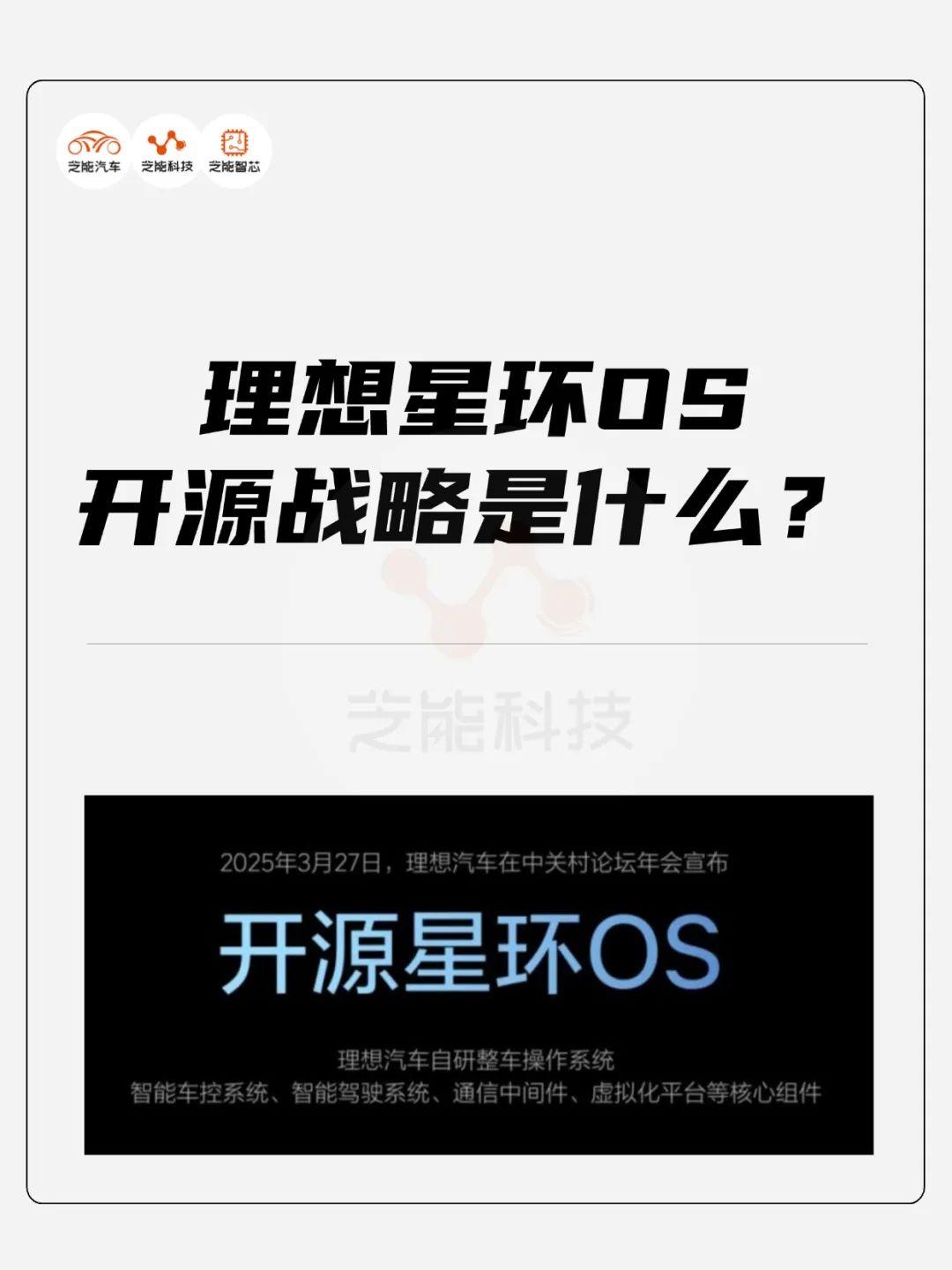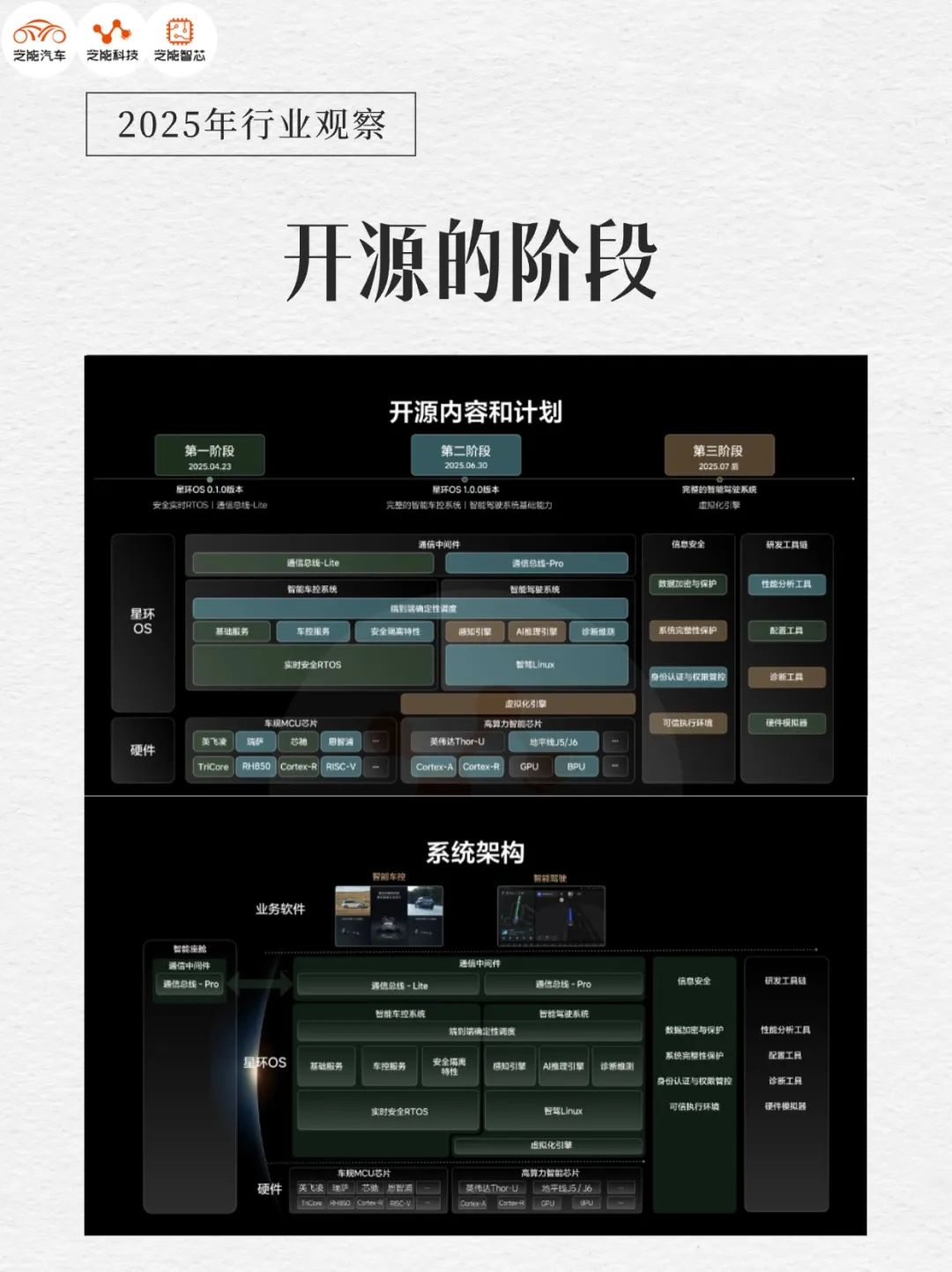In-depth Interview | Unveiling the Wisdom Behind LIXIANG StarRing OS's Open Source Initiative
![]() 04/17 2025
04/17 2025
![]() 698
698
Produced by Zhineng Technology
Recently, we engaged in an insightful dialogue with Xie Yan, CTO of Lixiang One, delving into the technical rationale and industrial significance of the StarRing OS open source strategy.
Drawing from the interview, we provide a nuanced analysis of StarRing OS's design philosophy, open source model, and its potential impact on the automotive industry, focusing on technical execution and ecosystem development.
StarRing OS, a foundational operating system encompassing vehicle control, intelligent driving, and vehicle communication, transcends the limitations of traditional automotive OSes (like AUTOSAR) through decoupled design, computing power pooling, and rapid adaptation toolchains.
Adopting the Apache License for open sourcing ensures data sovereignty and usage freedom, fostering the transition from 'intelligent systems' to 'smart systems' through industry-wide collaboration.
In practice, StarRing OS has enhanced Lixiang One's R&D efficiency and provided a unified framework for suppliers and automakers, minimizing redundant investments. While developing an open source system in China presents challenges, it is a worthwhile endeavor. Hurdles such as industry acceptance, technical adaptation, and community governance could influence its long-term ecosystem evolution.
We aim to offer a comprehensive perspective for readers intrigued by LIXIANG OS, particularly how Lixiang One is redefining its technical and industrial approach.

01
Technical Implementation:
Design Philosophy and Breakthroughs of StarRing OS
Central to our curiosity is understanding StarRing OS's core architecture, key innovations, and its distinctions from traditional automotive OSes.
StarRing OS, in essence, is a next-generation smart car's foundational OS, spanning vehicle control, intelligent driving, chassis, and vehicle communication, aiming to furnish a robust platform for multi-domain collaborative 'smart systems'.
Xie Yan clarified during the interview that StarRing OS is not a user OS (contrary to common misconceptions akin to Android) but rather a system software akin to a robot's 'brain, cerebellum, and neural network', supporting intricate applications like intelligent driving and vehicle control.
This positioning underscores the uniqueness of its technical design—a system unprecedented in the world but envisioned for future automotive and robotics industries.

StarRing OS surmounts the adaptability challenges of traditional automotive OSes through a highly decoupled architecture.
Xie Yan noted that traditional systems (like AUTOSAR) require months to adapt to new hardware due to their tight coupling. Conversely, StarRing OS introduces a hardware abstraction layer (HAL) to isolate the system layer from the application layer. For instance, when Lixiang One needs to replace a chip, StarRing OS's decoupled design allows adaptation without modifying the application layer, shortening the development cycle to weeks.
This design borrows from mobile internet experience, akin to Linux's modular kernel, ensuring flexibility across hardware platforms. StarRing OS provides a comprehensive toolchain, including compilers, debuggers, and deployment scripts, enabling automakers and chip manufacturers to swiftly port the system to development boards, significantly reducing adaptation costs.
From Lixiang One's perspective, a notable point is that automotive computing power is continually increasing, with different departments aspiring to their own intelligence. Hence, StarRing OS innovatively introduced the concept of 'computing power pooling' to optimize AI computing power allocation.
Currently, many industries grapple with AI computing power scattered across cabin, intelligent driving, and chassis domains, leading to resource wastage. StarRing OS centrally manages AI computing power through pooling technology and dynamically allocates it to different domain controllers. For instance, during high intelligent driving loads, the system can allocate idle cabin chip computing power to intelligent driving tasks.
Compared to the 'cabin-driving integration' solution (combining cabin and intelligent driving chips into a single SoC), computing power pooling avoids cost increases due to safety standard discrepancies while preserving each domain's iterative flexibility. For example, the intelligent driving domain necessitates ASIL-D safety certification, while the cabin only requires ASIL-B. The pooling design allows independent optimization of both, balancing performance and cost.

StarRing OS has undergone targeted optimizations for real-time performance and safety. Smart cars must ensure low latency and determinism from decision-making to execution, such as controlling autonomous driving's perception-to-braking response within 10 milliseconds.
StarRing OS reduces task communication latency to microseconds through a real-time operating system (RTOS) and efficient scheduling algorithms, a 50% improvement over traditional systems.
● In terms of safety, the system supports end-to-end encryption and redundancy checking to ensure data and instruction confidentiality and integrity during communication. Meanwhile, rigorous R&D quality processes meet ISO26262 functional safety requirements. These features empower StarRing OS to support multi-agent collaborative operations, like simultaneously handling intelligent driving, cabin entertainment, and chassis adjustment tasks.
Regarding how StarRing OS differs from AUTOSAR, its breakthrough lies in future-proof performance and scalability. AUTOSAR was designed for the functional vehicle era and struggles with the rapid iteration of AI-driven software and hardware.
StarRing OS supports the deployment of AI models with billions of parameters. For example, end-to-end intelligent driving algorithms require terabyte-level memory bandwidth. StarRing OS meets high throughput demands through distributed data access, memory pool optimization, and Ethernet communication.
A rapid adaptation case further illustrates its engineering value. Chip manufacturers originally required six months to provide an adapted system, but StarRing OS's toolchain shortened this timeframe, significantly enhancing R&D efficiency.
● From an engineering standpoint, StarRing OS's design embodies systematic thinking: the decoupled architecture enhances adaptation efficiency, computing power pooling optimizes resource utilization, and real-time performance and safety ensure functional reliability. These innovations provide a robust technical foundation for smart cars, but their success hinges on chip manufacturers' and automakers' collaborative adaptation capabilities.
02
Ecosystem Construction:
Industrial Logic and Collaborative Value of the Open Source Model
A pertinent question arises: Given its success, why open source it? StarRing OS's open source strategy is not merely a technical decision but a far-reaching industrial ecosystem layout.
Xie Yan repeatedly stressed during the interview that open sourcing aims to accelerate the transition from 'intelligent systems' to 'smart systems' through industry collaboration.
Put simply, Lixiang One, at the technological forefront, recognizes the challenges ahead. Exploring uncharted territories can be lonely.
Here, we analyze its enabling mechanism for the automotive industry from three facets: the open source model, ecological value, and potential impact.

● Open Source Model
◎ Lixiang One chose the Apache License for its open source agreement, embodying openness and non-control. StarRing OS incurs no fees, does not interfere with usage, and does not possess user data, akin to the deepseek weighted open source model; open source code offers additional advantages, facilitating industry collaboration and innovation.
◎ This permissive license ensures automakers' and suppliers' autonomy. Automakers can freely modify the code to align with their intelligent driving algorithms, and suppliers can optimize chip designs based on StarRing OS without commercial constraints. Unlike Android (where Google profits from service bundling), StarRing OS's 'no-return' model resembles Linux, aiming for technological iteration through community contributions.
◎ Xie Yan mentioned that the open source community will establish a committee and maintainers, encouraging automakers, suppliers, and even non-automotive companies to participate in version planning and code reviews. Greater contributions entail more influence. This governance structure mirrors the Apache Foundation, emphasizing transparency and collaboration.
● The ecological value of open sourcing lies in reducing redundant industry investments and fostering technical consensus. StarRing OS can annually save the automotive industry R&D costs, stemming from three aspects:
◎ Firstly, it addresses common technical challenges. For instance, real-time performance and safety necessitate hundreds of person-years of R&D. StarRing OS's mature solutions can be directly reused, saving over 50% of resources.
◎ Secondly, it optimizes hardware adaptation. Suppliers can pre-migrate software based on open source code, shortening the time for chips to be installed in vehicles by 30%.
◎ Thirdly, it minimizes 'reinventing the wheel', such as standardized development of vehicle control and communication systems, reducing project costs by 20%.
The supply chain's instability is evident. The chip change case discussed during the interview vividly illustrates the synergistic effect: When Lixiang proposed adding security IP for ECUs, closed-source model suppliers were reluctant to cooperate due to a single customer. However, post-open sourcing, suppliers saw potential demand from multiple automakers and proactively invested in R&D.
Objectively, once 'resonance at the same frequency' occurs, similar to the Android ecosystem, companies like Qualcomm optimize chips due to Android's popularity, fostering a positive feedback loop between hardware and software, yielding robust results.
● Potential Impact
◎ StarRing OS's open sourcing provides the automotive industry with a reference blueprint. The industry is transitioning from fragmented functional development to centralized system design. For example, multi-domain fusion necessitates unified communication protocols and computing power scheduling.
◎ As a 'public protocol', StarRing OS defines standards for real-time performance, safety, and AI computing power, guiding automakers and suppliers towards common goals. For instance, a Tier 1 supplier can develop domain control systems based on StarRing OS to serve multiple automakers, reducing costs by 15% due to economies of scale.
◎ For small and medium-sized enterprises, open sourcing lowers the technical threshold. Automakers can deploy intelligent driving and cabin applications without developing their own OS, shortening the R&D cycle by 6-12 months. This inclusivity is crucial for second- and third-tier automakers, who can obtain technical support through the community and avoid high closed-source licensing fees.
● Of course, valuable endeavors encounter difficulties and challenges. Advancing the open source model faces multiple hurdles.
◎ The automotive industry's acceptance is well-documented. The industry is accustomed to project-based and closed-source development. Although engineers are familiar with open source, corporate decisions require time to verify StarRing OS's stability. For instance, an automaker may fear commercial secret leakage due to code transparency or customization difficulties due to limited development capabilities.
◎ The second challenge is technical adaptation difficulty. StarRing OS must support multi-architecture chips and complex domain controllers. Initial debugging could take hundreds of person-months, straining suppliers with limited resources. Lixiang plans to alleviate this through white papers, technical documentation, and chip pre-adaptation, but community support's depth remains crucial.
◎ Finally, there's community governance sustainability. An open source ecosystem requires active contributors for maintenance. The automotive industry's scale is much smaller than mobile phones (200 million vehicles annually vs. 1 billion units), potentially limiting the community's size.
Notably, Lixiang One has boundaries, emphasizing 'no customer service team, relying on the community model'.
● From an industrial perspective, StarRing OS's open source strategy is not merely technology sharing but an ecosystem reshaping attempt. Through open protocols and community collaboration, it reduces industry barriers and accelerates the intelligentization process. However, its effectiveness depends on automakers' participation and suppliers' response speed.
Summary
LIXIANG StarRing OS's open source strategy merits contemplation and understanding.
At the technical level, its decoupled architecture, computing power pooling, and real-time performance optimization establish a leading edge, supporting the vision of a multi-agent collaborative smart system.
On an industrial scale, the Apache License and its community governance model dismantle technical obstacles, fostering a collaborative environment among automakers, suppliers, and chip manufacturers. This ecosystem has the potential to yield significant savings in R&D costs. Over the next 3-5 years, the success of StarRing OS will hinge on the refinement of white papers and toolchains, feedback from early adopters, and the vibrancy of community contributions.
I firmly believe that StarRing OS not only infuses technological dynamism into Lixiang One but also offers a commendable perspective for the development of the entire industry.







